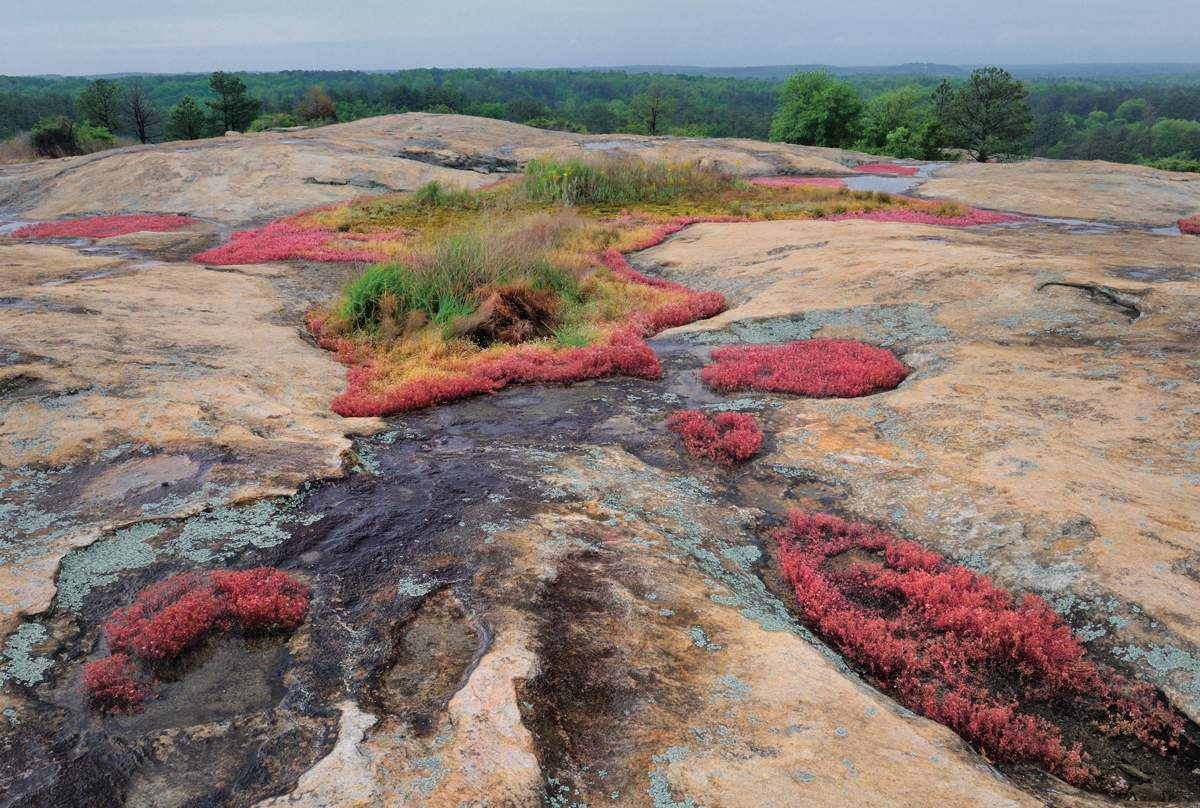
Photograph by Eric Bowles
In 2015, when my wife and I moved to Atlanta, I was looking for familiarity. I found it in a granite rock called Arabia Mountain. We’d been living in the Kingdom of Eswatini, formerly Swaziland, and then in Ghana. The move to the U.S. was a shock to the system. For a while, I was content to enjoy the variety of goods in all the enormous big-box stores, but soon I missed our life abroad—especially a granite monolith in southern Africa called Sibebe.
When I first moved to Eswatini in 2010, brought there by a Fulbright fellowship, I lived just a few miles away from Sibebe, so I climbed it many times—but always with someone who knew the best way up. While it’s not very tall, Sibebe is so steep that, at a glance, it doesn’t seem possible to climb without ropes. But the ground has such incredible traction that I’ve seen daredevilish people run up and down its side. I was not one of those people.
When I hiked Sibebe with my future wife, Miranda, for the first time, I thought I’d been up it enough times that I could lead us. We became frozen with fear in a particularly steep area; I was so scared I’d fall, or that she would, that I cried. But we found our footing and made it up to see the stunning valley behind it, filled with caves, building-sized boulders, and, depending on the season, tall grass, grazing cows, and swimming holes.
When we moved to Atlanta, to be closer to our families in the U.S., we didn’t even consider there would be something like Sibebe here. We were wrong. Not long after arriving, Miranda found an injured possum near the house we rented in Edgewood. I drove it to AWARE Wildlife Center—a nonprofit in Stonecrest that helps rehabilitate animals—and, while there, saw people near the parking lot heading the opposite direction, into the Davidson–Arabia Mountain Nature Preserve.
Arabia Mountain is a 400-million-year-old rock that juts 172 feet above a lake that borders it to the east. It’s a monadnock, which means that when it rises from the ground, it does so quite dramatically. The mountain was quarried for more than a century, and you can find pieces of it in the Brooklyn Bridge and in Atlanta curbs. Farmers used to feed Arabia rock to chickens because the grit was said to help them break down food.
When Miranda and I first climbed Arabia Mountain ourselves, it reminded us so much of Sibebe—the panoramic views and moonlike terrain, large puddles filled with seasonal plant life. At the top of the mountain, you can always find a quiet spot to look at the sky and the treetops and think in peace. (It’s more difficult to find shade.) On a weekday, you’ll likely be up there by yourself. To me, who missed Eswatini so much, Arabia Mountain felt like home.
One of the beauties of Arabia Mountain is that it is not a challenge to climb. It’s not nearly as steep or tall as Sibebe or the more infamous Stone Mountain. There aren’t stairs or a railing, but the strong grip of the granite makes it climbable for almost anyone. When Miranda was pregnant and long overdue and the stress was overwhelming, we climbed Arabia, big belly and all. I can still see the anxious expression on her face beginning to calm as she stood on the crest under the clouds. When our son was born and we could barely handle the first few weeks of parenthood, we climbed Arabia again, this time as a three-person family.
The last hike I ever took with my dad was up Arabia Mountain, before Parkinson’s disease took the remainder of his strength and, later, his life. By then, he was already walking with a shuffle, his feet barely lifting off the ground. But he made it, my confused but proud dad, to the top of the mountain.
When the pandemic hit, and we were stuck at home like everyone else, one of the first things we did when we braved the world again was climb Arabia with a friend who’d offered to take family photographs among the unusual granite formations and foliage. There we were, on top of the world, as our one-year-old son explored the rocks. He had only been walking a few months, but the traction of Arabia Mountain held him firm on his feet.
This article appears in our October 2022 issue.













